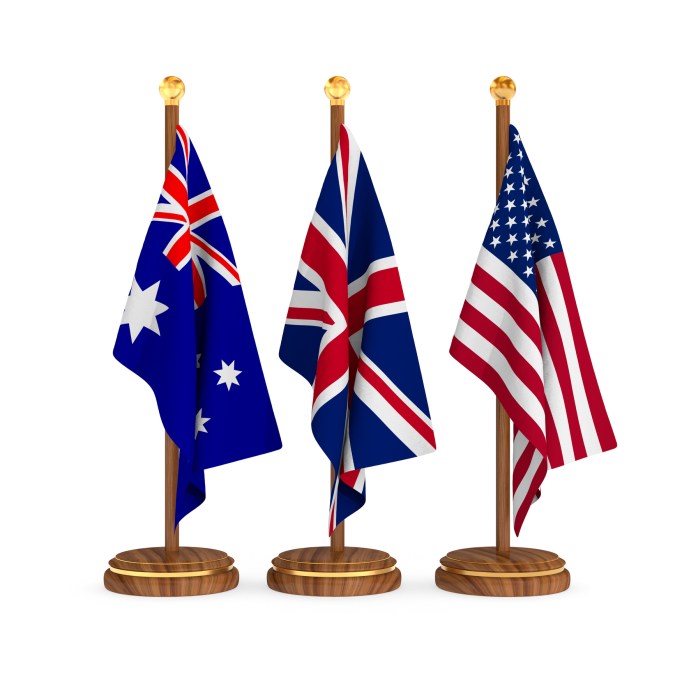U.S. flaunts diverse drones, high-altitude balloons and more at AUKUS event in Australia

In Australia’s Jervis Bay this week, military and industry officials from that Pacific nation, the U.S. and U.K., joined by observers from Japan, are engaging in a multi-day demo and technology showcase to advance a wide variety of AI-enabled drones, integration platforms and other emerging warfare capabilities needed to support real-world conflict and deterrence operations.
That large-scale modernization affair — Autonomous Warrior 2024 — marks AUKUS’ signature event this year and is part of the alliance’s new Maritime Big Play series of integrated trilateral experiments and exercises, two senior defense officials told a small group of reporters on a call Wednesday.
“Maritime Big Play allows AUKUS partners to practice fielding and maintaining thousands of uncrewed systems, gaining valuable experience operating in coalitions to solve realistic operational problems, such as improving undersea situational awareness,” said Madeline Mortelmans, acting assistant secretary of defense for strategy, plans and capabilities.
The AUKUS alliance is structured around two pillars.
While the first of those encompasses the co-development of a nuclear-powered submarine force for Australia, Pillar 2 focuses on the co-creation and deployments of emerging and disruptive military technologies.
Via Pillar 2, Mortelmans noted, AUKUS members are “implementing a fundamental shift to more closely integrate our systems and break down barriers to collaboration at every stage and in every part of our system.”
Broadly, the MBP series is designed to push forward the Pillar 2 objective to rapidly translate cutting-edge capabilities into practical, asymmetric assets delivered quickly to service members in the field.
Through it, the international partners aim to collaboratively test and refine the alliance’s capacity to jointly operate uncrewed systems at sea, transmit and process intelligence and reconnaissance data from all three nations, and supply real-time maritime domain awareness to strengthen decision-making.
“What we’ve been doing with this experimentation campaign is to ensure that when different gear shows up in the fight and into theater, it can be included seamlessly to provide common operating pictures and common control systems, and to ensure effects as and when we choose to have them as a coalition,” a senior defense official who joined Mortelmans but spoke on the condition of anonymity, told reporters on Wednesday.
DefenseScoop asked the two officials whether any of the autonomous or other combat capabilities were identified by AUKUS participants as a tool that would make sense for more rapid fielding and use in military operations in the near term.
“Some of them already are,” the senior defense official said. “There are some systems — uncrewed surface vessels in Australia — that have been put out on the ocean. And some of the things that we saw during this experimentation campaign was data coming back from those systems in real-time to maintain a common operating picture.”
They further told DefenseScoop: “Part of doing the Maritime Big Play is to see the realm of what’s available and to make those kinds of decisions. But at this point, we haven’t even completed the exercise, so no decisions have been taken to acquire or rapidly accelerate any system.”
On the call, the two senior defense officials opted not to explicitly name any of the technology brands or companies that made the sensors, platforms, drones, or network and communications systems the U.S. brought to Autonomous Warrior 2024.
However, in an email from Australia shortly afterwards, Pentagon spokesperson Army Maj. Pete Nguyen shed more light on the exact prototypes and technologies America demonstrated during the event.
The list he provided includes, among others:
- High Altitude Balloons (HABs) that “augment the space domain by providing resilient communications in a denied environment from the stratosphere by carrying a range of mission capable payloads” — from Aerostar, based in Sioux Falls, South Dakota.
- Greenough Advanced Rescue Craft (GARC), which are “low-cost attritable [small uncrewed surface vehicles or sUSVs] that can deploy independently or as a formation … and provide an uncrewed means to respond to Anti-Access/Area Denial (A2AD)” — from MAPC, in Baltimore, Maryland.
- Sea Stalker sUSV that’s “designed to serve in multiple maritime missions to include reconnaissance, surveillance, intelligence collection” — from Swift Ships, a small business based in Morgan City, Louisiana.
- Triton “multi-model Autonomous Underwater and Surface Vessel capable of persistent operation in a contested environment with threat detection and evasion capabilities” — from Ocean Aero, a small business in Gulfport, Mississippi.
- A “Government-Owned, Non-Proprietary Common Control System” that gives “U.S. Navy uncrewed vehicles hardware and software that works across several different systems” and helps process data from sensor payloads.
“This is only the first in our series of experiments and demonstrations. Over time, Maritime Big Play will grow and evolve to reflect emerging technologies, new systems and new operational requirements,” Mortelmans told reporters Wednesday.
Notably, during that call she also mentioned that members of the Japanese military joined this round of Maritime Big Play experimentation as “observers.”
AUKUS leaders have made it clear that they are open to expanding the trilateral security partnership to include other nations — solely under Pillar 2, not Pillar 1 — to jointly strengthen the interoperability of their maritime drone systems.
“Planning for the next exercise is underway. So the full details of what [Japan’s] participation will be in the future hasn’t yet been determined, but I think that they will move from being an observer to being a participant in the activity. And what a participant means could be bringing Japanese systems and platforms participating in that command-and-control architecture. There’s a wide range of opportunities and we’re really eager to explore those,” the senior defense official told DefenseScoop.






